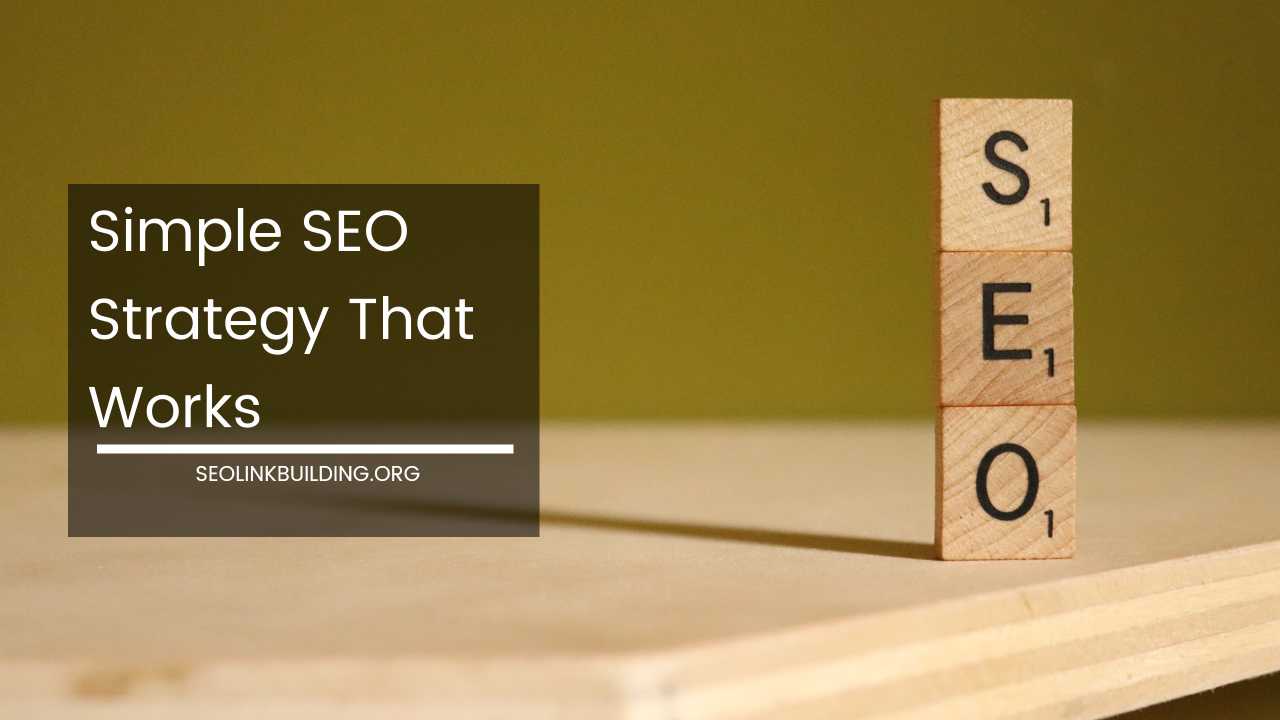Simple SEO Strategy That Works

Simple SEO Strategy That Works: A Beginner’s Guide to Higher Rankings
In today’s digital landscape, a strong online presence is no longer a luxury, it’s a necessity. Search Engine Optimization (SEO) is the key to unlocking that potential, helping your website get discovered by the right audience at the precise moment they’re searching for what you offer. But SEO can seem like a complex labyrinth, especially for beginners.
Fear not! This comprehensive guide outlines a simple yet effective SEO strategy that will equip you with the knowledge and actionable steps to build a solid foundation and climb the search engine rankings ladder.
We’ll delve into the fundamentals of SEO, provide practical tips, and explore advanced strategies to help you navigate the ever-evolving SEO landscape.
Understanding the Why: The Compelling Benefits of SEO
Before diving headfirst into SEO tactics, let’s explore the compelling benefits it offers:
- Increased Organic Traffic: Attract a steady stream of high-quality visitors who are actively searching for the products, services, or information you offer. This targeted traffic translates into valuable leads and potential customers.
- Enhanced Brand Awareness: Higher search engine rankings make your website more visible to a wider audience. This increased exposure translates into greater brand recognition, establishing you as a thought leader in your niche.
- Improved Credibility and Trust: Strong SEO signals to search engines that your website is trustworthy and relevant. This translates into enhanced brand authority and fosters trust with potential customers.
- Cost-Effective Marketing: SEO is an organic strategy, meaning you don’t have to pay for every click. It’s a long-term investment that delivers sustainable growth and a higher return on investment (ROI) compared to traditional advertising methods.
The Three Pillars of SEO: A Framework for Success
Effective SEO can be broadly categorized into three core pillars, each playing a crucial role in boosting your website’s ranking potential:
- On-Page SEO: Optimizing the content and structure of your website’s individual pages for both search engines and user experience. This is what you have direct control over.
- Off-Page SEO: Building your website’s authority and credibility by earning backlinks (links from other websites) that point to your content. This requires strategic outreach and content creation.
- Technical SEO: Ensuring your website is technically sound and crawlable by search engines, allowing them to properly understand, index, and rank your pages. This focuses on the behind-the-scenes functionality.
Building a Strong Foundation: Mastering On-Page SEO
On-page SEO focuses on optimizing the elements you can directly control on your website. Here’s a breakdown of the key strategies and actionable steps:
-
Keyword Research: The Cornerstone of Success
- Identify Relevant Keywords: Conduct thorough keyword research to identify the terms and phrases people use to search for topics related to your business or niche. Free and paid keyword research tools like Google Keyword Planner, Ahrefs, or SEMrush can be invaluable assets. These tools help you discover relevant keywords with high search volume, low competition, and high commercial intent (the likelihood of converting searchers into customers).
- Target Long-Tail Keywords: Don’t just focus on broad, high-volume keywords, as they can be highly competitive. Instead, prioritize long-tail keywords, which are more specific and have lower competition. These targeted keywords can drive high-quality traffic from users who are further along in the buying journey.
- Integrate Keywords Naturally: Once you’ve identified your target keywords, integrate them naturally throughout your content, including titles, headings, subheadings, meta descriptions, and throughout the body text. However, avoid keyword stuffing, which can negatively impact your rankings and user experience.
-
Content is King: Create High-Quality Content
- Audience Focus: Remember, you’re not just writing for search engines, but for your target audience. Create high-quality, informative, and engaging content that caters to their specific needs, interests, and search intent.
- Content Variety: Go beyond blog posts and explore different content formats like infographics, videos, case studies, and white papers. This caters to different learning styles and preferences, keeping your audience engaged and coming back for more.
- Freshness Matters: Search engines favor websites with fresh content. Develop a consistent content creation strategy and publish new content regularly to keep your website active and relevant.
-
Optimize Titles and Meta Descriptions
- Compelling Titles: Craft compelling and informative title tags for your pages. Titles should be concise (ideally under 60 characters), keyword-rich, and accurately reflect the content of your page. They should grab users’ attention and entice them to click.
- Meta Descriptions: The Click-Through Catalyst: Meta descriptions are short summaries (ideally under 160 characters) that appear in search results beneath your title tag. Optimize your meta descriptions to provide a clear and concise overview of what users can expect to find on your page. Include your target keywords naturally and craft a compelling call to action to encourage users to click through.
-
Structure Your Content for Readability
- Headings and Subheadings: Break down your content with clear headings (H1, H2, H3 tags) and subheadings to improve readability and user experience. This makes it easier for users to scan your content and find the information they’re looking for. It also helps search engines understand the structure and hierarchy of your content.
- Bullet Points and Lists: Use bullet points and numbered lists to present complex information in an easily digestible way. This improves scannability and makes your content visually appealing.
- Paragraph Length: Aim for shorter paragraphs (3-5 sentences) to avoid overwhelming your readers. White space is essential for improving readability, especially on mobile devices.
-
Image Optimization: Don’t Neglect the Visuals
- Relevant Images: Include relevant and high-quality images throughout your content to enhance user engagement and visual storytelling.
- Image Optimization: Optimize your images for size and quality. Large image files can slow down your website loading speed, which can negatively impact your SEO. Use tools to compress images without sacrificing quality.
- Descriptive File Names and Alt Text: Don’t just rely on visuals alone. Use descriptive file names and alt text for your images. Alt text provides context for screen readers and search engines, improving accessibility and SEO ranking potential.
The Power of Backlinks: Building Authority with Off-Page SEO
Off-page SEO focuses on building your website’s authority and credibility by earning backlinks (links from other websites) that point to your content.
Search engines view websites with high-quality backlinks as more trustworthy and relevant, giving them a ranking boost. Here are some effective strategies to build a healthy backlink profile:
-
Create Link-Worthy Content: The foundation of a strong backlink profile is high-quality content that deserves to be linked to. Focus on creating informative, unique, and valuable content that establishes you as an authority in your niche. People are naturally more likely to link to content that is insightful, engaging, and fills a gap in their audience’s knowledge.
-
Guest Blogging: Guest blogging on relevant websites in your niche is a powerful way to build backlinks and gain exposure to a new audience. Reach out to website owners and editors, offering to contribute high-quality guest posts that align with their content strategy. Ensure the websites you target have a good reputation and domain authority to maximize the SEO benefit.
-
Broken Link Building: Find broken links on websites in your niche that link to outdated or irrelevant content. Reach out to the website owners and suggest your content as a replacement. This is a win-win situation: you get a valuable backlink, and they improve their website’s user experience.
-
Online Reputation Management: Building a positive online reputation can naturally attract backlinks. Engage with your audience on social media, respond to online reviews, and participate in relevant online communities. When you establish yourself as a thought leader and a trusted source of information, others are more likely to link to your website.
Technical SEO: The Unsung Hero of Search Rankings
Technical SEO ensures your website is built in a way that search engines can easily understand and navigate. While it might sound daunting, here are some essential technical SEO steps to get you started:
-
Mobile-Friendliness is Paramount: In today’s mobile-first world, it’s crucial to ensure your website is responsive and provides a seamless user experience across all devices, especially smartphones and tablets. Google prioritizes mobile-friendly websites in search results, so neglecting this aspect can significantly hinder your SEO efforts. Use Google’s Mobile-Friendly Test tool to assess your website’s mobile responsiveness and identify areas for improvement.
-
Website Speed Optimization: A slow website can significantly hurt your SEO rankings and user experience. People are impatient, and if your website takes too long to load, they’ll bounce off and head to your competitor’s website. Here are some tips to improve website speed:
- Choose a Fast Web Host: Invest in a reliable web hosting provider that offers excellent server speed and uptime.
- Optimize Image Size: As mentioned earlier, use tools to compress images without sacrificing quality. Large image files can significantly slow down your website loading speed.
- Minimize Code Bloat: Unnecessary code and plugins can bloat your website’s code, slowing it down. Regularly review your website’s code and remove any unused plugins or scripts.
-
Site Structure and Internal Linking: Create a clear and logical site structure with internal linking to improve website navigation for both users and search engines. Here’s how:
-
- Flat Site Structure: For smaller websites with limited content, a flat site structure can work well. This means all your important pages are only a few clicks away from the homepage.
- Hierarchical Site Structure: For larger websites with a significant amount of content, a hierarchical site structure is recommended. Organize your content into categories and subcategories, making it easier for users to find what they’re looking for.
- Internal Linking Strategy: Link to relevant pages within your website throughout your content. This helps search engines understand the relationship between different pages on your website and distribute link value throughout your site. However, avoid excessive internal linking, as it can appear unnatural.
-
Structured Data Implementation: Structured data (also known as schema markup) is a way to provide search engines with additional information about your content, making it easier for them to understand and interpret. This can lead to richer search results, including things like product ratings, reviews, and event details. While not a direct ranking factor, structured data can improve click-through rates by providing users with more informative search snippets.
-
XML Sitemap Creation and Submission: An XML sitemap is a file that lists all the important pages on your website. Submitting your sitemap to search engines like Google and Bing can help them discover and index your content more efficiently. Most website builders and content management systems (CMS) allow you to generate an XML sitemap automatically.
Beyond the Basics: Advanced SEO Techniques
As you gain confidence in your SEO skills, you can explore more advanced techniques to further refine your SEO strategy:
- Local SEO for Brick-and-Mortar Businesses: If you have a local business, focus on local SEO strategies like claiming your Google My Business listing, optimizing your website for local keywords, and building local citations (online mentions of your business name, address, and phone number).
- Earning High-Quality Backlinks: Not all backlinks are created equal. Focus on acquiring backlinks from high-authority websites in your niche. These backlinks carry more weight and can significantly boost your SEO ranking potential.
- Content Promotion and Link Building Strategies: Develop a content promotion strategy to amplify your content’s reach and attract high-quality backlinks. Share your content on social media, submit it to relevant online communities, and reach out to influencers in your niche for promotion opportunities.
- Voice Search Optimization: With the rise of voice search, consider optimizing your content for conversational keywords and long-tail queries. People tend to use more natural language when searching with voice assistants, so tailor your content accordingly.
SEO is a Journey, Not a Destination: Continuous Monitoring and Improvement
Effective SEO is an ongoing process that requires continuous monitoring and adjustments. Here are some tips to stay on track:
- Track Your Progress: Utilize SEO tools and analytics platforms like Google Search Console to monitor your website’s performance. Track your keyword rankings, organic traffic, and website health to identify areas for improvement.
- Stay Updated on SEO Trends: The SEO landscape is constantly evolving. Stay updated on the latest SEO trends and algorithm updates by following reputable SEO blogs and industry publications.
- Test and Refine: Don’t be afraid to experiment with different SEO strategies and tactics. A/B testing allows you to compare different approaches and identify what works best for your website.
Final Thoughts: Building a Successful SEO Strategy
By incorporating these SEO strategies into your website development and content creation process, you’ll be well on your way to climbing the search engine rankings ladder and attracting a steady stream of qualified traffic to your website.
Remember, SEO is a long-term game, so focus on creating high-quality content, building a strong online presence, and providing exceptional value to your target audience.
As you consistently implement these SEO best practices, you’ll witness your website authority and organic traffic grow over time, achieving your online marketing goals.













